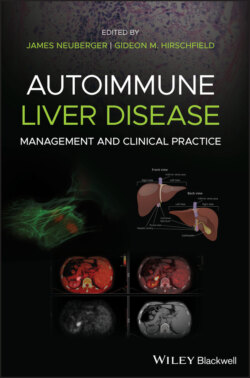Читать книгу Autoimmune Liver Disease - Группа авторов - Страница 35
Cholangiocytes and Immunity
ОглавлениеBECs are a first line of defense in liver innate immunity: they can present antigen to immune cells, be a target of immune‐mediated aggression, or be the initiators of an inflammatory reaction that then progresses to adaptive immune activation [9]. The contribution of BECs to liver immune responses was initially believed to be limited to the secretion of immunoglobulin A (IgA) into the bile, but it is now clear that their role in the immune response is far more complex. The biliary epithelium stands as a first line of defense against bacteria, fungi and other pathogens by secreting antimicrobial peptides such as defensin and cathelicidin. A major role in epithelial innate immunity in BECs is played by Toll‐like receptors (TLRs) and by nuclear receptors. TLRs can recognize pathogen‐associated molecular patterns (PAMPs), i.e. bacterial elements such as lipopolysaccharide (LPS), DNA and RNA fragments, but also respond to endogenous components or damage‐associated molecular patterns (DAMPs), such as hyaluronan and high mobility group box 1 (HMGB1) that are released from damaged cells. TLR4‐mediated signaling is the better studied in cholangiocytes. Once activated by LPS or other ligands, TLR4 activates two different pathways, one mediated by NF‐κB, which stimulate the expression of a number of proinflammatory cytokines and chemokines, and one mediated by mitogen‐activated protein kinase (MAPK)/activator protein 1 (AP‐1), which requires the nuclearization of the AP‐1 complex. In normal cholangiocytes, TLR4 signaling is repressed by protective mechanisms aimed at maintaining LPS tolerance. Since the biliary epithelium is continuously in contact with bacterial products of intestinal origin, changes in one or more regulatory checkpoints may trigger an exaggerated inflammatory response in the liver. For example in cystic fibrosis‐related liver disease, a decrease in LPS tolerance plays a major role in the development of the disease. A continuous stress in the absence of a correct modulation of the TLR‐mediated responses could be the trigger for a chronic inflammatory or autoimmune response.
Nuclear receptors, particularly the retinoid X receptor (RXR), have recently been involved in the immune response of BECs. This is a receptor superfamily that includes the glucocorticoid receptor, the retinoic acid receptor, the VDR, the liver X receptors, and the peroxisome proliferator‐activated receptors (PPARs). Nuclear receptors control several cell functions including cell proliferation and apoptosis, cell metabolism, cell–cell interaction, detoxification from BAs, and bile secretion.
In addition, continuous exposure to DAMPs and PAMPs could promote cellular senescence. Cell senescence is a mechanism of irreversible cell arrest in G1 stage induced by different stimuli. The main causes responsible for the onset of senescence are DNA damage (particularly but not exclusively) to the telomeres, the activation of mitogenic signals induced by oncogene activation, epigenetic modifications, and expression of tumor suppressor genes. All these signals lead to different physiologic responses generally leading to tumor suppression; however, in some cases it could promote cancer development or induce a fibrosing response and mediate age‐related degenerative diseases. Once senescent, cells not only cease proliferation but assume a senescence‐associated secretory phenotype (SASP) characterized by the secretion of a plethora of peptides with profibrogenic, proinflammatory, and tumorigenic properties. This indicates that senescence could not only act as a barrier to tumor growth, but also paracrinally stimulate the activation of aberrant reparative/regenerative responses. In chronic biliary diseases, cholangiocyte senescence is likely the result of ongoing inflammation, a sort of “exhaustion” of the activated cholangiocytes. This is particularly important in PSC, given the association with cholangiocarcinoma.
